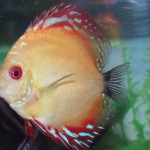
I just realized I never wrote about that very important aspects of successful fish keeping: water changes. This might be obvious for many of us but it is certainly not for everyone. Yesterday, I received two calls from people looking for an answer to their problems: The first tank wasn’t cycled after 6 months (ho yeah!) and the 2nd had a serious (I mean… SERIOUS!!!) nitrate problem. Two problems that could have been avoided with regular water changes.
There’s no getting around it; very aquarium needs a water change once in a while.
How Often?
There is no standard answer to the question of how often water should be changed. Many factors can influence how fast your water quality declines: tank size, number of fish, feeding routine, etc. Some will need weekly water changes while others will do well with a water change every few months.
The best way to know is to test for nitrates. A nitrate test won’t tell you everything but it is an useful indicator of water quality. As a rule of thumb, water should be changed when nitrates reach levels of 30 ppm (this is just a guideline). Some fish requires pristine water so take the time to know your fish (and invertebrates) before to decide what levels can be considered acceptable.
How Much?
Here again, all tanks are different. Keep in mind that a 25% water change will only remove 25% the nitrate, phosphate, etc. Testing for nitrate will tell you lot about how much should be changed. If your nitrate level goes from 10 ppm to 50 ppm within a week, you might want to change more water so you won’t have to change the water too often. If your nitrate levels goes from 10 pm to 15 ppm, smaller water changes should be good.
DON’T CHANGE TOO MUCH WATER! The more water you change, the more you risk to break the nitrogen cycle, make drastic chemistry change, etc. Unless you know what you do, 50% water change should be the maximum.
How To Do Water Changes?
Material needed:
-A siphon (Python type hoses are awesome!)
-2 buckets (if you don’t use a Python hose).
-Water conditioner
Procedure:
1. If you use a Python hose, you may skip this first step. If you don’t use a Python hose, fill a bucket with fresh tap water. Add water conditioner to the water to remove chlorine. Make sure the water at the same temperature to that of your aquarium.
2. Unplug all electrical units: heater, filter, air pump (you can keep the lights).
3. Clean the inside glass using an algae scrubber, scraper, razor blade or sponge. Don’t use sharp objects on an acrylic tank!
4. Siphon the water with your siphon and vacuum the gravel at the same time (see video bellow). Push the siphon straight down into the gravel and then pull straight up to remove all the debris trapped in it. Repeat as you move across the bottom. You might not be able to completely clean the gravel when you do a water change and this is ok. Do a different section of the gravel next time you do a water change. Don’t remove more water than what you have in the other bucket.
5. If you are using a Python hose, water will go directly down the drain. If you are using buckets, fill the other bucket with the water you siphon from the aquarium.
6. Now you can begin refilling. If you are using a Python hose and want to use water straight from the tap, allow it to run for a few minute to reduce the concentration of copper and heavy metals from household plumbing. Use this time to adjust the temperature to that of your aquarium. Once the aquarium if full, use water conditioner directly in the aquarium.
If you are not using a Python hose, gently pour the water bucket (the one with new water) into the aquarium. Refill the tank slowly to not disturb the gravel, plants and fish.
7. Open your filter and look at the filter media (cartridge, activated carbon, sponge, floss, etc…). It is advised to not clean or change filter media the same day you do a water change but at least you’ll know if you need to clean the filter later this week.
8. Dry your hands and plug in all your electrical units again.
9. Wipe down the hood and outside glass of your tank.
10. Record your activity in a maintenance log.
IMPORTANT NOTICE: Never use a glass cleaner or any other chemical to clean your tank.
That’s it! Remember that nothing can take the place of routine water changes to keep your water clean and your fish healthy. It seems like a lot of steps, but once you get the hang of it, it doesn’t take very long to complete this procedure.














